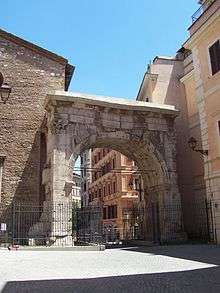Arch of Gallienus
| Arch of Gallienus | |
|---|---|
 | |
| Location | Regione V Esquiliae |
| Built in | AD 262 |
| Built by/for | Marcus Aurelius Victor |
| Type of structure | Triumphal arch |
| Related |
List of ancient monuments in Rome |
 Arch of Gallienus | |
The Arch of Gallienus is a name given to the Porta Esquilina, an ancient Roman arch in the Servian Wall of Rome. It was here that the ancient Roman roads via Labicana and via Tiburtina started. The arch was rebuilt in monumental style in the Augustan period.[1] In 262, the equestrian (Marcus) Aurelius Victor[2] rededicated the arch to the emperor Gallienus and his wife Cornelia Salonina.
Site

It still stands in the Via di S. Vito (the ancient Clivus Suburanus - the sequel, the Via S. Madonna dei Monti, follows the course of the ancient Argiletum, the main road to the Roman Forum).
Already in the Augustan period the Porta Esquilina should be included in the Esquiline Forum, that included the market called the Macellum Liviae. When these buildings were abandoned in late antiquity, the diaconia and monastery of San Vito (cited in the Einsiedeln Itinerary) took them over, cited already in the itinerary of Einsiedeln. It is this church against which the arch's remains now rest.
Architecture
The surviving single arch is of travertine, 8.80 metres high, 7.30 wide, and 3.50 deep. The piers that support it are 1.40 metres wide and 3.50 deep, and outside of them are two pilasters of the same depth, with Corinthian capitals. The entablature is 2 metres high with the dedicatory inscription on the architrave. Beneath the spring of the arch on each side is a simple cornice. A drawing (HJ 343) of the 15th century shows small side arches, but all traces of them have since disappeared (PAS ii.76; Sangallo, Barb. 25v.).
Inscription
GALLIENO CLEMENTISSIMO PRINCIPI To Gallienus, the most clement princeps, CVIVS INVICTA VIRTVS SOLA PIETATE whose unconquered virtus is only outdone SVPERACTA EST ET SALONINAE by his pietas, and to Salonina, SANCTISSIMAE AVGVSTAE AVRELIVS most holy Augusta, Aurelius VICTOR V[ir] E[gregius] DICTATTISSIMVS Victor, the excellent man,
[dedicated this] in complete devotionNVMINI MAIESTATISQVE EORVM to their numines and majesties
These two surviving lines represent the end of an inscription.[3] The large rectangular blank space above them had marble slabs fixed onto it, with the beginning of the inscription - the drilled holes for these slabs' metal fixings are still visible. These lost slabs probably named Gallienus's father Valerian as the first dedicatee (with Gallienus following in the dedication as the second dedicatee as Valerian's heir and co-emperor, rather than as sole emperor and first dedicatee). However, this would have been removed after Valerian was captured in the disastrous Sassanid expedition of 259, leaving only the surviving inscription above that was carved into the architrave itself.
References
- ↑ Thein, Alexander. "Porta Esquilina" in Digital Augustan Rome.
- ↑ Mennen, Inge. "Power and Status in the Roman Empire, AD 193-284" in Volume 12 of The Impact of Empire, Koninklijke Brill, Leiden, the Netherlands, 2011. Page 230.
- ↑ CIL VI.1106; ILS 548
Sources
Coordinates: 41°53′45″N 12°30′05″E / 41.895779°N 12.501361°E